Donor Stewardship: Key Tips to Build Relationships


Full Platform Overview Chat With Us



Full Platform Overview Chat With Us




The foundation of an effective fundraising strategy is the relationships your team forms with the people who power your mission.
Every member of your nonprofit team already knows how to build strong relationships with friends, co-workers, family members, significant others, and more. Magic happens when you build relationships with prospects and donors. This is where donor stewardship comes into play.
This guide covers everything you need to know to develop a powerful donor stewardship strategy that builds genuine, long-lasting relationships. We’ll cover:
A solid donor stewardship plan ensures your donors feel seen and appreciated, setting your organization up for long-term fundraising success.
Donor stewardship is the act of building relationships with supporters after they donate to your nonprofit. A donor stewardship plan is a long-term strategy to strengthen those relationships to earn repeat donations from these individuals. This process involves thanking donors, learning about them as individuals, and demonstrating their impact through follow-up communications.
You may have heard the term “donor cultivation” used interchangeably with “donor stewardship.” Both of these terms fall under the umbrella of donor relationship-building, but they differ in key ways:
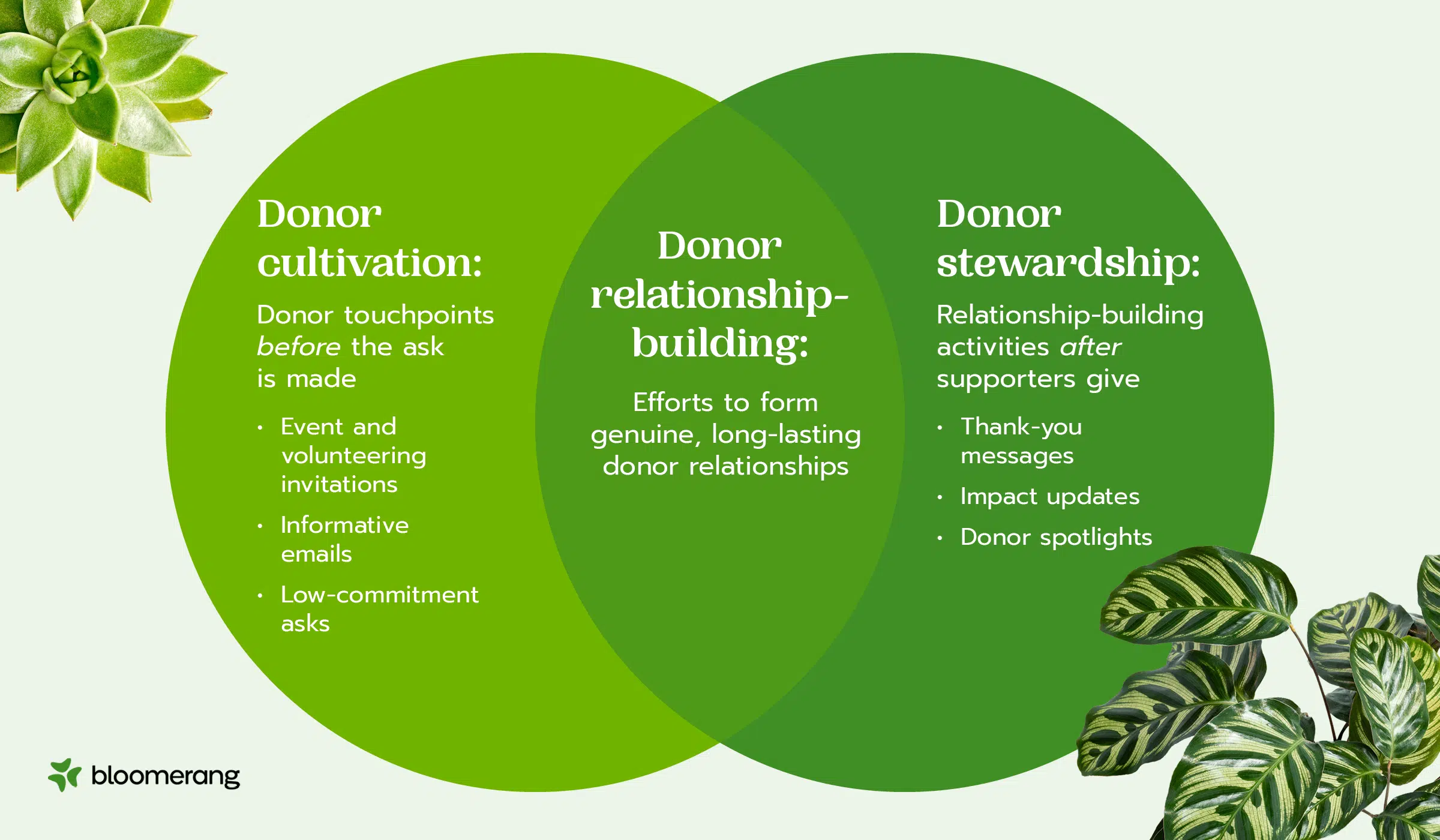
Stewardship focuses primarily on maintaining relationships with donors after donating to show gratitude and secure long-term support.
Your donor retention rate measures how many donors continue to give to your organization over time. You can calculate your organization’s retention rate by dividing the number of donors who gave again this year by the number of all donors who contributed last year.
By investing in donor stewardship and current donor relationships, you can retain their support, strengthen your community, and limit donor acquisition costs
You can tell from your donor retention rate if you have a solid contingent of donors who give to your nonprofit time after time, or you’ll see if you’re struggling to retain donors. If you relate to the latter, you’re not alone—according to data from the most recent Fundraising Effectiveness Project reports:
“Q2 2024 saw a 3.7% increase in dollars raised, while both the number of donors and donor retention fell by -3.9% and -4.5%, respectively. These trends mirror those seen in Q1 2024, albeit the increase in dollars raised is smaller while the decrease in the number of donors and retention rates is larger.”
When new donors give only once, you experience a loss on the initial investment to acquire those new supporters. As you know, there’s a cost associated with bringing in new donors—the money spent on your donor acquisition efforts. That’s one reason why focusing on retaining donors is important—it’s much more cost-effective for your organization in the long run.
Your nonprofit’s staff may have limited time and resources to build donor relationships. The donor pyramid can be a valuable tool for prioritizing donor stewardship efforts and focusing most of your efforts on high-impact donors.
The donor pyramid is a visual representation of the different giving and engagement levels present in your nonprofit’s core audience. Your largest, most significant donors are at the top because they’re fewer in number but have the highest impact.
Here are the standard levels of a donor pyramid:
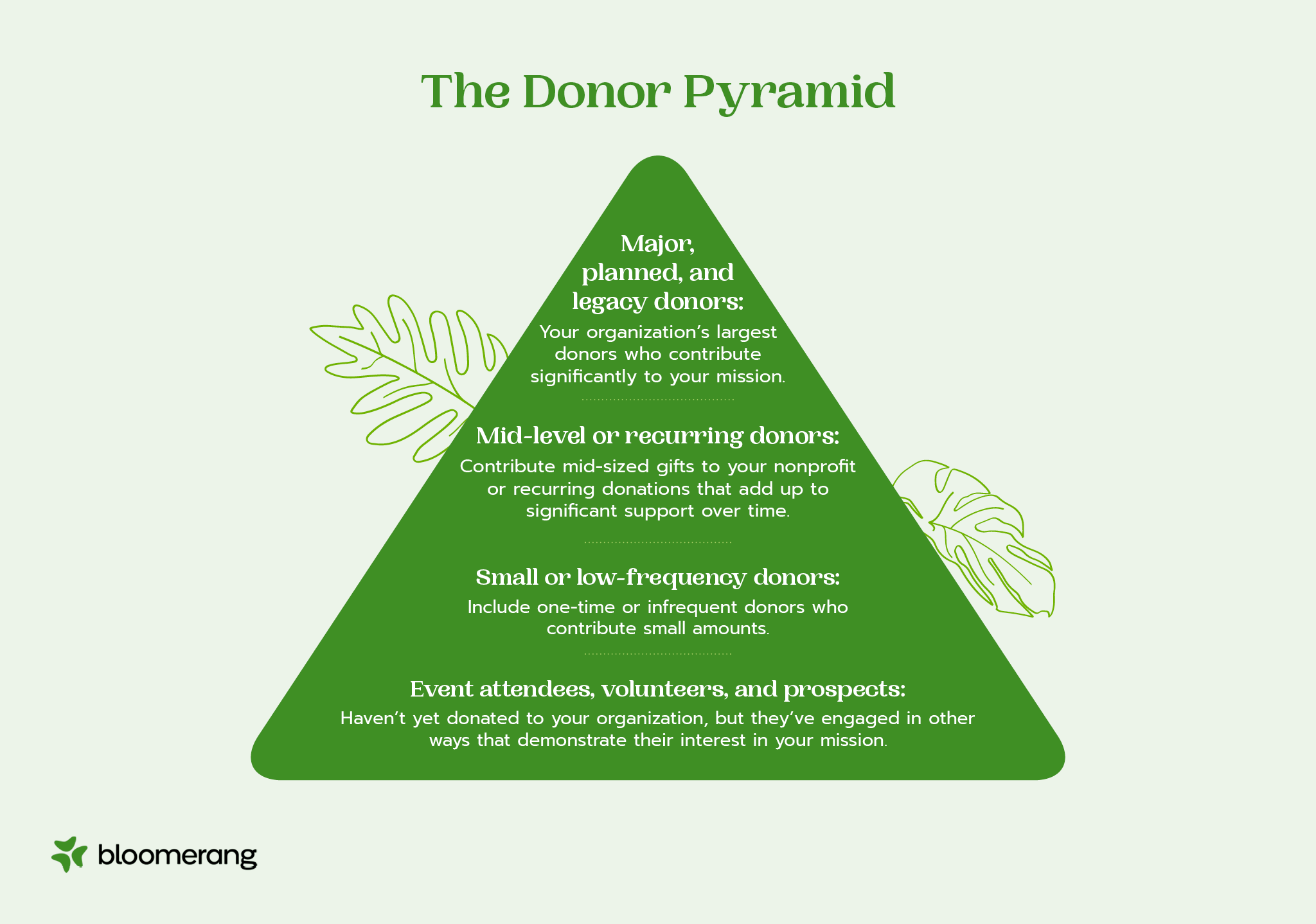
Your nonprofit should steward donors at every level of the pyramid but use different strategies corresponding to each group’s level of engagement with your fundraising activities. Use the following table for personalized ideas:
| Donor group | Level of engagement with fundraising | Current level of impact on your fundraising efforts | Stewardship ideas |
| Major, planned, and legacy donors | High | High | Private meetings with your nonprofit’s executive director, personalized impact reports demonstrating their long-term impact, naming rights for programs or buildings |
| Mid-level or recurring donors | High | Mid to high | Personalized event invites, recurring impact updates, tiered recognition programs, donor spotlights in your email newsletter, thank-you phone calls |
| Small or low-frequency donors | Mid to low | Mid | Immediate donation gratitude emails and receipts, matching gift or upgrade reminders, email newsletter updates, seasonal greetings |
| Event attendees, volunteers, and prospects | Low | Low | Post event or volunteer opportunity gratitude emails, low-commitment requests like subscribing to your email newsletter, mission-related educational emails, and background information |
As you can see, you should dedicate your most personalized and comprehensive stewardship efforts to donors at the top of your pyramid. These donors have the greatest potential to significantly impact your nonprofit’s efforts to achieve its mission, so they deserve highly personalized interactions.
Mid-level donors should also receive a high level of engagement since they make gifts that add up meaningfully over time and can even become major or legacy donors later on. According to a Sea Change Strategies report, 59% of mid-level donors give annually; over half have been involved with the participating organization for a decade or more. In addition, 31% have made a bequest to the participating organization, and 23% say they plan to make one later.
Lastly, supporters toward the bottom of the pyramid should still receive a variety of recognition emails and invitations to get more involved with your cause, even if they’re not currently highly engaged in fundraising. This attention can encourage them to increase their involvement and eventually become donors.
The donor stewardship process begins when a supporter donates to your cause for the first time. Your donor stewardship plan will outline how you encourage these individuals to continue supporting your cause.
Review the steps of the donor stewardship journey below: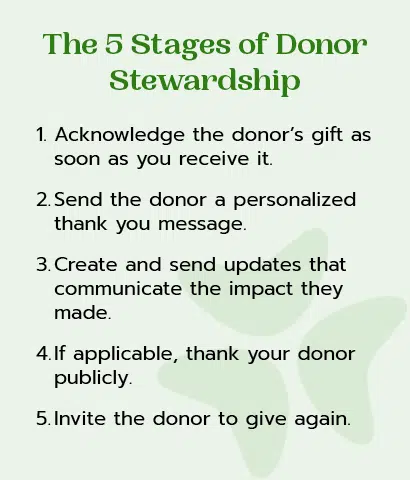
This is a general outline of the stages of the donor stewardship process, but your organization can incorporate additional engagement strategies based on each individual’s position in the donor pyramid.
Now that you know the basics, you can start stewarding your donors using your nonprofit’s unique strengths. Use the following best practices to get started on the right foot.
Every plan requires a strong team to help see it through. Create a team to lead your donor stewardship efforts, ensuring each individual has a clearly defined role.
Depending on the size of your staff, your donor stewardship team might consist of the individuals featured in the graphic below.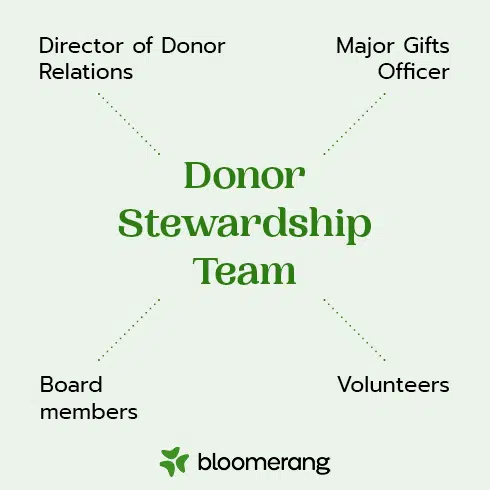
It’s important to ensure that each team member understands their role in supporting your stewardship efforts so that everyone is on the same page and there is no overlap or gap in responsibilities.
Establish a clear communication cadence that keeps donors updated throughout the stewardship process—without sending them too many emails in a short period of time, as this can cause email fatigue. Use analytics from your email marketing platform and social media pages to determine when supporters are most active. This data can help you decide how to space out your donor communications.
Your first email or letter to the donor should describe your mission, projects, and goals. Your follow-up communications should include more information about how you used their donation, why you’re grateful for their support, and your future goals.
Using an email provider that integrates with your donor database, you can automate your donor communications to reach donors based on where they are in the stewardship process. This ensures you communicate with donors regularly and saves your team time.
When you first reach out to new donors, remind them what you do and why their donation matters. As you do that, leave a positive impression on donors by:
By keeping donors updated on your work and ensuring all interactions with them are positive, you’ll build deeper and more authentic relationships with them. This should help you win a second donation from them—and, hopefully, many more in the future.
Donor segmentation is a tactic where you group supporters based on shared characteristics. This practice allows you to create a more personalized experience for donors without going through the time-consuming process of creating unique messages for every person who interacts with your nonprofit.
Donor segmentation also lets you send donors the information they’re most likely to engage with. This shows them that you care about connecting them with opportunities that appeal to their motivations and interests.
You might create donor segments based on the following criteria:
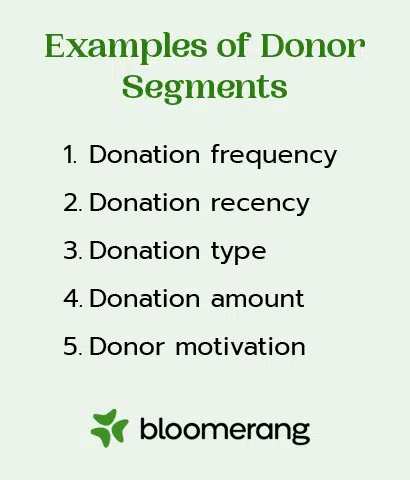
Determine which segments make the most sense for your nonprofit. Then, create personalized and relevant messages for each segment.
You should communicate with donors through various communication platforms. An effective donor stewardship strategy uses both online and traditional marketing channels.
Here are the platforms and channels you might use to connect with your donors:
Track your donor outreach using your donor database. This will help you see which outreach efforts are or aren’t effective and inform you how to adjust your strategy accordingly.
When donors give to your organization, they expect you to use their donations as you say in your outreach messages or online donation page.
For example, if you said a donation would support your volunteer program or purchase new equipment for your community center, ensure you do those things and let your donors know when you’ve done them. This transparency helps build trust between your organization and your donors, which will encourage your donors to support your organization in the future.
One way to increase donor loyalty is to show donors you appreciate their input. You can do this by asking them for feedback and implementing reasonable changes they request (as long as they align with your mission and put your resources to the best use).
Send out regular donor surveys asking what they think about things like how you can improve your fundraising events or how they’d like you to communicate with them in the future.
Creating memorable experiences for donors keeps your organization on the top of their minds. This is important for winning a second donation from first-time donors and getting your current donors to give again, more often, or in larger amounts.
Here are a few ways you can create memorable moments for your donors:
Your attempts to create memorable moments for donors will help your organization stand out.
Effective donor stewardship includes a combination of tried-and-true strategies and robust software solutions to be successful. Look into your options for effective fundraising software like Bloomerang to help power your stewardship efforts. Bloomerang can help you:
Review our customer stories to see how why nonprofits using the Bloomerang Giving Platform see an average constituent growth of 12% year-over-year.
Ultimately, we recommend approaching donor stewardship with curiosity and a willingness to meet your supporters where they are. The more genuine and meaningful your stewardship efforts are, the more effortlessly you’ll be able to retain donors long-term.
If you’re looking for more resources to help build your donor stewardship plan, start here:
Comments
Kristen Hay
Terri Davis